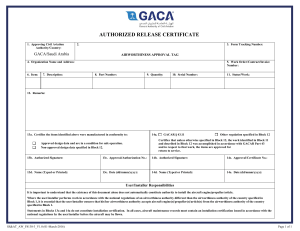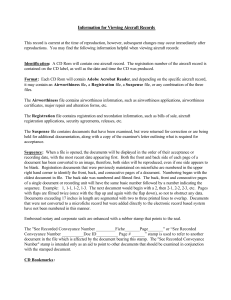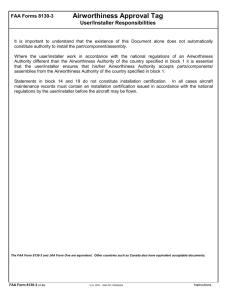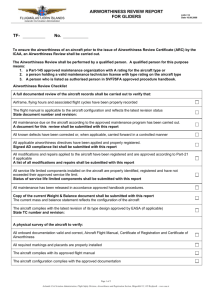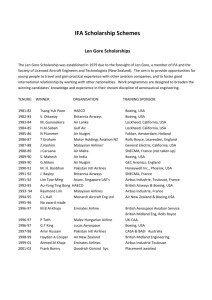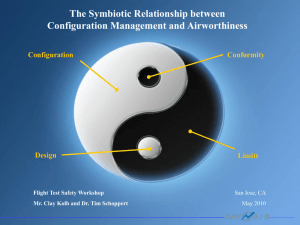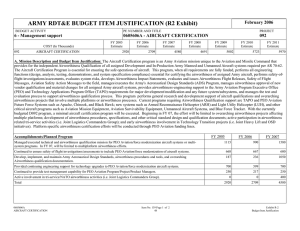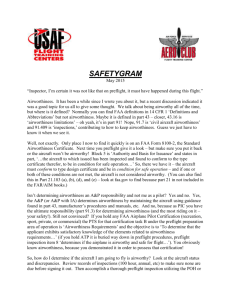An academic view of Human Factors in Maintenance Simon Place
advertisement
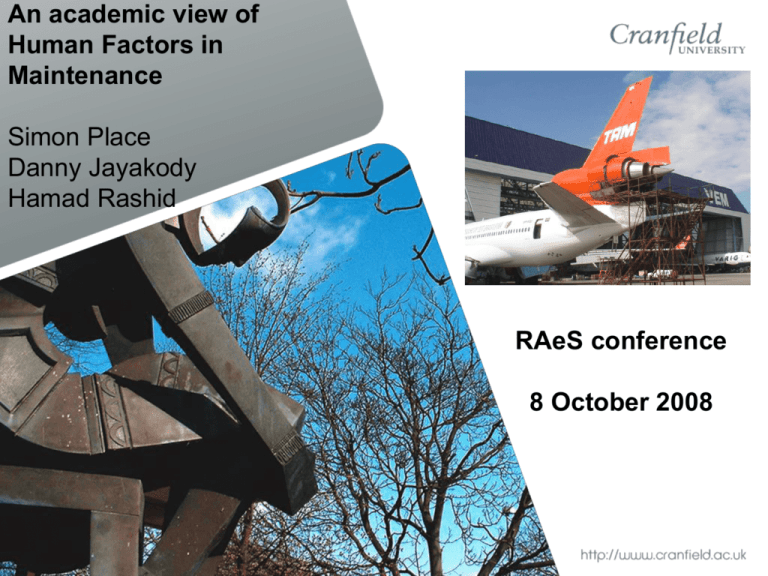
An academic view of Human Factors in Maintenance Simon Place Danny Jayakody Hamad Rashid RAeS conference 8 October 2008 A limited selection of recent research 1. Maintenance error – Proposal for Error Management in Numerical Airworthiness Terms [Simmons, 2002] 2. Maintenance error prediction modelling [Leach, 2005] 3. A critical analysis of the links between the taxonomies used by MEDA & HFACS-ME [Eshati, 2006] 4. Aviation Maintenance Monitoring Process (AMMP) [Rashid] 5. Risk Assessment in Continuing Airworthiness of Air Transport [Jayakody] Error Management in Numerical Airworthiness Terms ECI [Simmons, 2002] Catastrophic Error Criticality Indices (ECI) Major Minor 1.00 0.00 10E-3 10E-6 10E-9 Probability • Estimate the criticality of a maintenance task, based on: – – – – Effect if left uncorrected at Release To Service (RTS) The severity of that effect Where in the maintenance sequence it occurs Whether an adverse outcome has been anticipated in design Error Management in Numerical Airworthiness Terms [Simmons, 2002] Assessment of Data from Human reliability analysis maintenance tasks Modify with Performance shaping factors Evaluate ECI Difference calculation No action Introduce new controls / re-design Consider cost savings • Compare the criticality against the probability of error derived from existing Human reliability tools. • Identify any required changes needed to meet an acceptable risk Risk Factor Analysis [Leach, 2005] Combination of Failure modes and effects analysis (FMEA) and MSG-3 • Expert System of Engineers (ES) analyse maintenance tasks: • Likelihood of Occurrence – range from 1 (almost impossible) to 16 (almost certain) • Event severity – range from 2 (not noticeable) to 24 (probable aircraft loss) • Detection – range from 1 (easy to detect) to 16 (difficult) Risk factor = likelihood x severity x detection Risk Factor Analysis [Leach, 2005] WARNING: Flight safety possibly endangered, additional safety nets are required Insufficient control measures currently applied 1740 MODERATE: Flight safety is not endangered, but financial penalties often exist Model proved to be effective at identifying key events - risk factor between 2 and 6144 550 STANDARD: existing control measures are probably sufficient Links between MEDA and HFACS-ME [Eshati, 2006] • To apply HFACS-ME and MEDA human factor taxonomies to the same incident and accident reports to identify the causal contributing factors of the errors. • To identify the applicability, effectiveness and limitations of both tools (MEDA and HFACS-ME). HFACS - Maintenance Extension Management Conditions Organizational Supervisory Medical Maintainer Conditions Crew Coordination Working Conditions Environment Equipment ource: Naval Safety Center chool Of Aviation Safety Readiness Workspace Maintainer Acts Error Violation ACCIDENT Application of modelling options (Source: Rashid / Jayakody) CAW Study (Bayesian Logic) AMMP (Fuzzy Logic) Work Place / Tasks / Aircraft Supervision / Immediate Management Higher Management / Decision Makers Regulator / Policy Designer Continuing Airworthiness / Strategic Issues Task arena/ Detail issues Intermeshing errors at manufacturer (aircraft / • This research manages maintenance task) and immediate workplace levels. • Rotary-wing aircraft are taken as case study. Aviation Maintenance Monitoring Process (AMMP) • To identify Root Causes of human errors in helicopter maintenance for both individual and organizational levels. • To conduct retrospective and prospective analysis, under the HERMES [Cacciabue, 2004] methodology • Retrospective HFACS-ME applied to study 58 reports of incidents and accidents related to maintenance • To verify integrity of the developed process within helicopter maintenance industry. Fuzzy Analytical Network Processes Model ANP Goal Preliminary Steps Error Potentiality Weighting of (XI) Aircraft Maintenance Job No. (x.y.z) ANP Model Main Maintenance Tasks Parts Removal Paint Stripping Calculating potentiality of maintenance error for a given task (x). Parts Cleaning Sub Maintenance Tasks Adjust levels / pressures / flows Checks/ Readings/ Measurements Adjust cable tensions / rod connections Adjust pipe connections / Seal leakages Troubleshooting/ Analysis/ Decision Making Repair electrical connections / generators / c. breakers / batteries / bulbs / warnings Adjust voltages / currents / resistances Topping/ Charging/ Installation/ Fixing/ Sealing/ Adjustment Autopilot / computers / navigators / Radio Perform structural / parts repairs / Balance Install serviceable parts G Inspection Functional Test Rotary parts balancing / Vibration control Engines / Hydraulics / Pneumatics / Air Final Steps Mechanical fits / joints / fixation / torques Re-set the ‘‘on-the-way’’ systems / parts Fuzzy ANP [Chang 1992, 1996, adapted by Rashid] µA(x) 1.0 EI WMI SMI VSMI AMI 1 3/2 2 5/2 3 0.5 0.0 1/2 7/2 x • Prospective: ANP weighs task errors potentialities from both designing and immediate workplace variables concerning that task. • Direct product: Weighting error potentiality of maintenance tasks and subtasks. • Error risk = f (Potentiality, Criticality). Fuzzy Comparison Matrices Pair-wise comparison of importance for tasks within a given maintenance job Prep Preparation 1,1,1 Removal Checks Analysis Installation Function Test x, y, z Removal Checks Analysis Installation Function Test 1/x, 1/y, 1/z 1,1,1 1.1.1 1.1.1 1.1.1 Overall output: Full detailed risk ranking of maintenance errors for a given task (changing the main rotor of a given helicopter). 1,1,1 Risk Assessment in Continuing Airworthiness [Jayakody] 1. 2. 3. 4. Aims of research 2007-2010 To design and develop a generic model for risk assessment in continuing airworthiness process To determine a method to optimise regulatory oversight programme on the basis of risk To determine if parts of regulatory oversight inspections could be devolved To determine how expert opinion could be represented as a measurable parameter in a decision analysis tool Risk Assessment in Continuing Airworthiness 2007-2010 • Risk-based oversight (RBO) from Hampton Report recommendation (leading to “Better Regulation”). • ICAO mandate on Safety Management Systems • Follow-on from Regulatory Oversight Weighting Index (C/SI) • Analytical Hierarchical Process (AHP) – adopted by Dutch CAA for assessing risk within MROs: – Assess risks from Quality (Part reqts and Quality system) and Organisation (Culture, features and process) – Make an implicit risk analysis more explicit – Informs the decision on intensity of supervision by regulator Bayesian Belief Networks Information B Prior P(A) Information C Posterior P(A l B) New Posterior P(A l C, B) • Means to quantify probability of accident scenario using “Conditional probability theory” • Estimate the conditional probability of one causal factor given the presence of other factors. • Conducted using fusion of data and “beliefs” of Subject Matter Experts (SME) Influence Diagram Source: Luxhoj, 2002 Consequence Task/Environment Individual Mn facility Task load Organisation Mn training Corporate deficiency Maint HR Regulator Knowledge/ Experience Maint Mgt Mn org struct Operator on oversight Work system design Repair Repair Inspection Failure Current status CAW Study (Bayesian Logic) AMMP (Fuzzy Logic) Work Place / Tasks / Aircraft Supervision / Immediate Management Higher Management / Decision Makers Regulator / Policy Designer Continuing Airworthiness / Strategic Issues Task arena/ Detail issues Intermeshing • AMMP – data gathering to start this year, with helicopter designers/maintainers • Risk in CAW – interest gained from military and civil operators and maintainers. Now undertaking design of models Bayes’ concept x in action Sectors failed due to document errors Sectors failed Total sectors flown for period Sectors not failed Document errors present but sector not failed Example of Bayes • Flight documentation is inspected regularly. 20% of late flights had experienced document errors; 30% of on-time flights had document errors. • 10% of flights are late. • What is the probability of document errors, given that flight is on-time? Solution • Let A = event that sector is late; p(A) = 0.1 and B = event that documents have errors. • 10% that were late (A) had document errors (B), so p(B|A) = 0.2 • 90% that were successful (Ā) had document errors (B), so p(B|Ā) = 0.3 • The probability of a sector being late (A), given that it has document errors (B) is written p(A|B) Using Bayes p(B | A).p(A) p(B | A).p(A) p(B) p(B | A).p(A) p(B | A ).p( A ) (0.2)( 0.1) 0.02 p( A | B) 0.07 (0.2)( 0.1) (0.3)( 0.9) 0.29 p( A | B)

